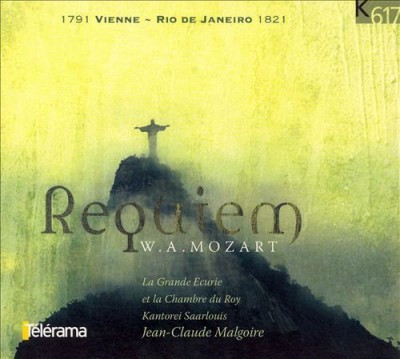Mezzo-Soprano: Gemma Coma-Alabert
Tenor: Simon Edwards
Bass-Baritone: Alain Buet
Choir: Kantorei Saarlouis
Orchestra: La Grande Ecurie et La Chambre du Roy
Conductor: Jean-Claude Malgoire
Date: 2005
Venue:
Cat No.: K617180
Released: 2005
But it’s good to hear Neukomm’s impressive piece, and the live performance of the whole Requiem is a strong one, apart from an unaccountably sluggish ‘Recordare’. Small deficiencies in ensemble are far outweighed by impressive choral singing that presents the text with unusual clarity and force. Malgoire allows the trumpets and trombones an important role in the overall texture, often giving it an unexpectedly fierce character. Their prominence in the ‘Confutatis’, however, distorts the music, focusing too much on Süssmayr, not enough on Mozart. And I wish the soloists had consistently matched up to the stylishness and clarity of the choir and orchestra. It’s nice when singers are able to take a cue from period instrumentalists and, for example, modify their use of vibrato.
— Duncan Druce, Gramophone [July 2006]
Musically, the extra music is certainly no worse than Süssmayr’s contribution, but to my ears it’s not significantly better either. Malgoire’s live performance lacks the security and warmth of the best accounts of the Requiem on disc, whatever version of the score they use.
— Andrew Clements, The Guardian [March 3, 2006]
Various commentators have felt that the conclusion is a bit of a letdown, but then the whole second half of the mass, being something less than Mozart and something more than Süssmayr, is the same way. For whatever reason, Austrian composer Sigismund Neukomm von Ritter wrote a new finale, a setting of the “Libera me” text, during a visit to Brazil in 1819. It is this version that is offered here by French historical-performance specialist Jean-Claude Malgoire, La Grande Ecurie et la Chambre du Roy, and the Kantorei Saarlouis choir.
The new “Libera me” isn’t likely to come into general circulation, but it does, as Malgoire and other commentators in the booklet contend, tell us a few things about Mozart’s Requiem. Neukomm was, like Mozart, a Freemason, and he matched closely the Requiem’s rather odd brass- and wind-heavy orchestration, which had links to the other Masonic works (including Die Zauberflöte) from the end of Mozart’s life. Malgoire stresses this aspect of the work, keeping his complement of strings small and sonically in the background. Yet the oddest thing about the Neukomm “Libera me” is that, for all the care Neukomm took in thinking about Mozart’s intentions; it doesn’t quite feel of a piece with the existing music by Mozart. Süssmayr was no Mozart, and he may not even have been a Neukomm. But he soaked up Mozart’s ideas in the last days of his life, and the Requiem as we have known it until now reflects that. This disc will certainly appeal to those interested in the Requiem and its reception. But it does not live up to the claim made on the packaging: that “Mozart’s final work at last yields up the secret of its conclusion.”
— James Manheim, AllMusic.com
